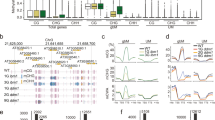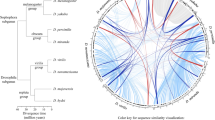Abstract
Heterochromatin has been defined as deeply staining chromosomal material that remains condensed in interphase, whereas euchromatin undergoes de-condensation1. Heterochromatin is found near centromeres and telomeres, but interstitial sites of heterochromatin (knobs) are common in plant genomes and were first described in maize2. These regions are repetitive and late-replicating3. In Drosophila, heterochromatin influences gene expression, a heterochromatin phenomenon called position effect variegation4. Similarities between position effect variegation in Drosophila and gene silencing in maize mediated by “controlling elements” (that is, transposable elements) led in part to the proposal that heterochromatin is composed of transposable elements, and that such elements scattered throughout the genome might regulate development2. Using microarray analysis, we show that heterochromatin in Arabidopsis is determined by transposable elements and related tandem repeats, under the control of the chromatin remodelling ATPase DDM1 (Decrease in DNA Methylation 1). Small interfering RNAs (siRNAs) correspond to these sequences, suggesting a role in guiding DDM1. We also show that transposable elements can regulate genes epigenetically, but only when inserted within or very close to them. This probably accounts for the regulation by DDM1 and the DNA methyltransferase MET1 of the euchromatic, imprinted gene FWA, as its promoter is provided by transposable-element-derived tandem repeats that are associated with siRNAs.
This is a preview of subscription content, access via your institution
Access options
Subscribe to this journal
Receive 51 print issues and online access
$199.00 per year
only $3.90 per issue
Buy this article
- Purchase on Springer Link
- Instant access to full article PDF
Prices may be subject to local taxes which are calculated during checkout




Similar content being viewed by others
References
Heitz, E. Das heterochromatin der Moose. Jehrb. Wiss. Botanik 69, 762–818 (1928)
McClintock, B. Chromosome organization and genic expression. Cold Spring Harb. Symp. Quant. Biol. 16, 13–47 (1951)
Hennig, W. Heterochromatin. Chromosoma 108, 1–9 (1999)
Schotta, G., Ebert, A., Dorn, R. & Reuter, G. Position-effect variegation and the genetic dissection of chromatin regulation in Drosophila. Semin. Cell Dev. Biol. 14, 67–75 (2003)
Fransz, P., De Jong, J. H., Lysak, M., Castiglione, M. R. & Schubert, I. Interphase chromosomes in Arabidopsis are organized as well defined chromocenters from which euchromatin loops emanate. Proc. Natl Acad. Sci. USA 99, 14584–14589 (2002)
CSHL/WUGSC/PEB, Arabidopsis Sequencing Consortium. The complete sequence of a heterochromatic island from a higher eukaryote. Cell 100, 377–386 (2000)
Arabidopsis Genome Initiative, Analysis of the genome sequence of the flowering plant Arabidopsis thaliana. Nature 408, 796–815 (2000)
Jurka, J. Repbase update: a database and an electronic journal of repetitive elements. Trends Genet. 16, 418–420 (2000)
Jenuwein, T. & Allis, C. D. Translating the histone code. Science 293, 1074–1080 (2001)
Vermaak, D., Ahmad, K. & Henikoff, S. Maintenance of chromatin states: an open-and-shut case. Curr. Opin. Cell Biol. 15, 266–274 (2003)
Martienssen, R. A. & Colot, V. DNA methylation and epigenetic inheritance in plants and filamentous fungi. Science 293, 1070–1074 (2001)
Lippman, Z., May, B., Yordan, C., Singer, T. & Martienssen, R. Distinct mechanisms determine transposon inheritance and methylation via small interfering RNA and histone modification. PLoS Biol. 1, E67 (2003)
Verbsky, M. L. & Richards, E. J. Chromatin remodeling in plants. Curr. Opin. Plant Biol. 4, 494–500 (2001)
Gendrel, A. V., Lippman, Z., Yordan, C., Colot, V. & Martienssen, R. A. Dependence of heterochromatic histone H3 methylation patterns on the Arabidopsis gene DDM1. Science 297, 1871–1873 (2002)
Kakutani, T. Epi-alleles in plants: inheritance of epigenetic information over generations. Plant Cell Physiol. 43, 1106–1111 (2002)
Sijen, T. & Plasterk, R. H. Transposon silencing in the Caenorhabditis elegans germ line by natural RNAi. Nature 426, 310–314 (2003)
Aravin, A. A. et al. Double-stranded RNA-mediated silencing of genomic tandem repeats and transposable elements in the D. melanogaster germline. Curr. Biol. 11, 1017–1027 (2001)
Volpe, T. A. et al. Regulation of heterochromatic silencing and histone H3 lysine-9 methylation by RNAi. Science 297, 1833–1837 (2002)
Martienssen, R. A. Maintenance of heterochromatin by RNA interference of tandem repeats. Nature Genet. 35, 213–214 (2003)
Barkan, A. & Martienssen, R. A. Inactivation of maize transposon Mu suppresses a mutant phenotype by activating an outward-reading promoter near the end of Mu1. Proc. Natl Acad. Sci. USA 88, 3502–3506 (1991)
Soppe, W. J. et al. The late flowering phenotype of fwa mutants is caused by gain-of-function epigenetic alleles of a homeodomain gene. Mol. Cell 6, 791–802 (2000)
Kinoshita, T. et al. One-way control of FWA imprinting in Arabidopsis endosperm by DNA methylation. Science 303, 521–523 (2004)
Nagaki, K. et al. Sequencing of a rice centromere uncovers active genes. Nature Genet. 36, 138–145 (2004)
Rabinowicz, P. D. et al. Genes and transposons are differentially methylated in plants, but not in mammals. Genome Res. 13, 2658–2664 (2003)
Pal-Bhadra, M. et al. Heterochromatic silencing and HP1 localization in Drosophila are dependent on the RNAi machinery. Science 303, 669–672 (2004)
Schramke, V. & Allshire, R. Hairpin RNAs and retrotransposon LTRs effect RNAi and chromatin-based gene silencing. Science 301, 1069–1074 (2003)
Verdel, A. et al. RNAi-mediated targeting of heterochromatin by the RITS complex. Science 303, 672–676 (2004)
Zilberman, D., Cao, X. & Jacobsen, S. E. ARGONAUTE4 control of locus-specific siRNA accumulation and DNA and histone methylation. Science 299, 716–719 (2003)
Seitz, H. et al. Imprinted microRNA genes transcribed antisense to a reciprocally imprinted retrotransposon-like gene. Nature Genet. 34, 261–262 (2003)
Chan, S. W. et al. RNA silencing genes control de novo DNA methylation. Science 303, 1336 (2004)
Xie, Z. et al. Genetic and functional diversification of small RNA pathways in plants. PLoS Biol. 2, E104 (2004)
Craig, B. A., Black, M. A. & Doerge, R. W. Gene expression data: the technology and statistical analysis. J. Agric. Biol. Environ. Stat. 8, 1–28 (2003)
Acknowledgements
We thank E. Richards and our colleagues T. Osborn, L. Comai, J. Chen and J. Birchler for their comments and advice. We also thank P. Rabinowicz for advice on ChIP microarray experiments. V.C. thanks M. Caboche for laboratory space and continuous support. Z.L. is an Arnold and Mabel Beckman graduate fellow in the Watson School of Biological Sciences. A.V.G. is supported by a graduate studentship from the French Ministry of Research. M.V. is a National Science Foundation Bioinformatics postdoctoral fellow. This work was supported by a grant from the NSF Plant Genome Program (to R.W.D. and R.M.), as well as grants from Genopole and the CNRS (to V.C.), grants from NSF and NIH to J. C., and NIH to R.M.
Author information
Authors and Affiliations
Corresponding authors
Ethics declarations
Competing interests
R. Martienssen and W. R. McCombie have financial interests in Orion Genomics LLC, a biotechnology company that has commercialized the DNA methylation profiling method under the trademark MethylScope.
Supplementary information
Rights and permissions
About this article
Cite this article
Lippman, Z., Gendrel, AV., Black, M. et al. Role of transposable elements in heterochromatin and epigenetic control. Nature 430, 471–476 (2004). https://doi.org/10.1038/nature02651
Received:
Accepted:
Issue Date:
DOI: https://doi.org/10.1038/nature02651
This article is cited by
-
Transposable elements as essential elements in the control of gene expression
Mobile DNA (2023)
-
The role of histidine kinase signalling in response to salt stress
Plant and Soil (2023)
-
Impacts of DNA methylases and demethylases on the methylation and expression of Arabidopsis ethylene signal pathway genes
Functional & Integrative Genomics (2023)
-
UV-B-induced modulation of constitutive heterochromatin content in Arabidopsis thaliana
Photochemical & Photobiological Sciences (2023)
-
Genome-wide identification of functional enhancers and their potential roles in pig breeding
Journal of Animal Science and Biotechnology (2022)
Comments
By submitting a comment you agree to abide by our Terms and Community Guidelines. If you find something abusive or that does not comply with our terms or guidelines please flag it as inappropriate.



